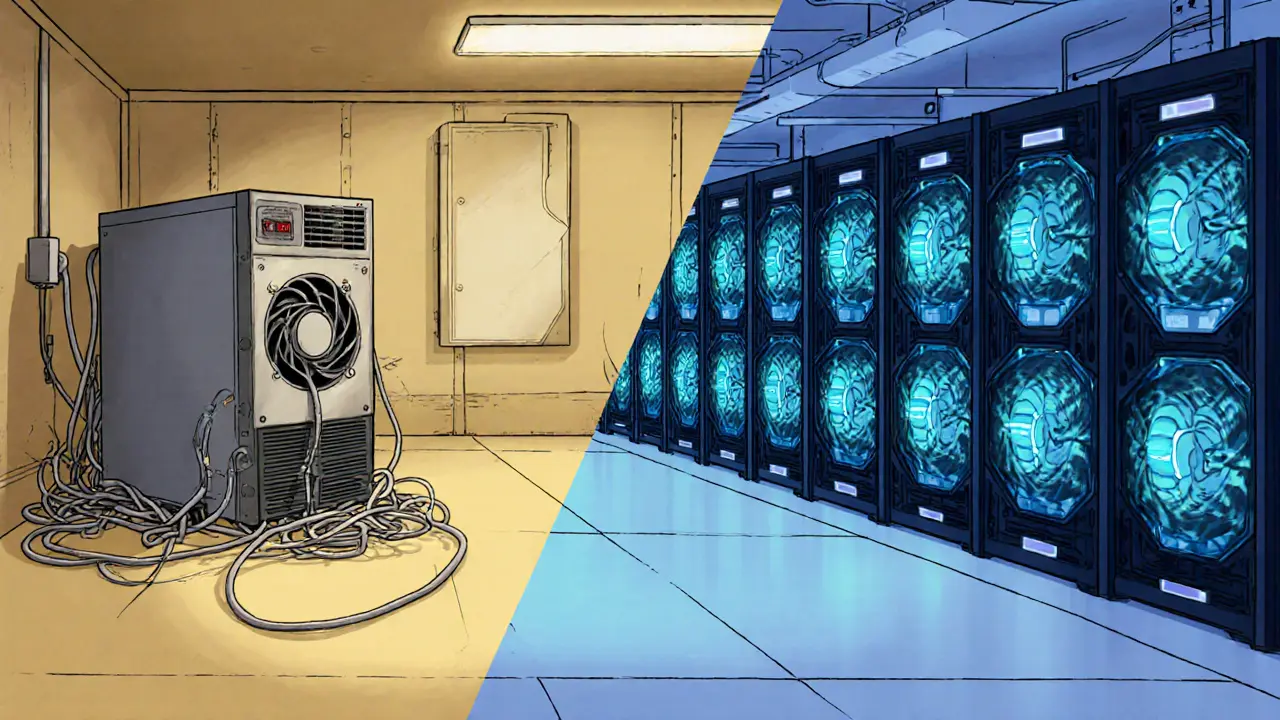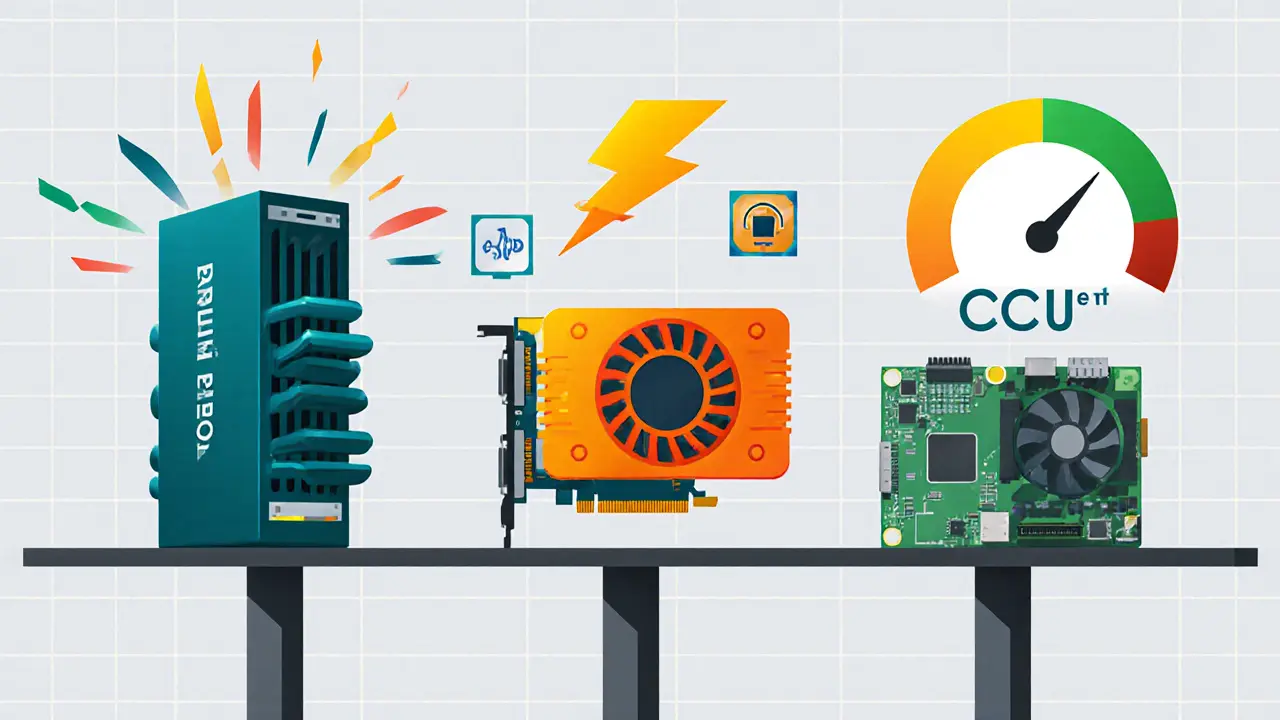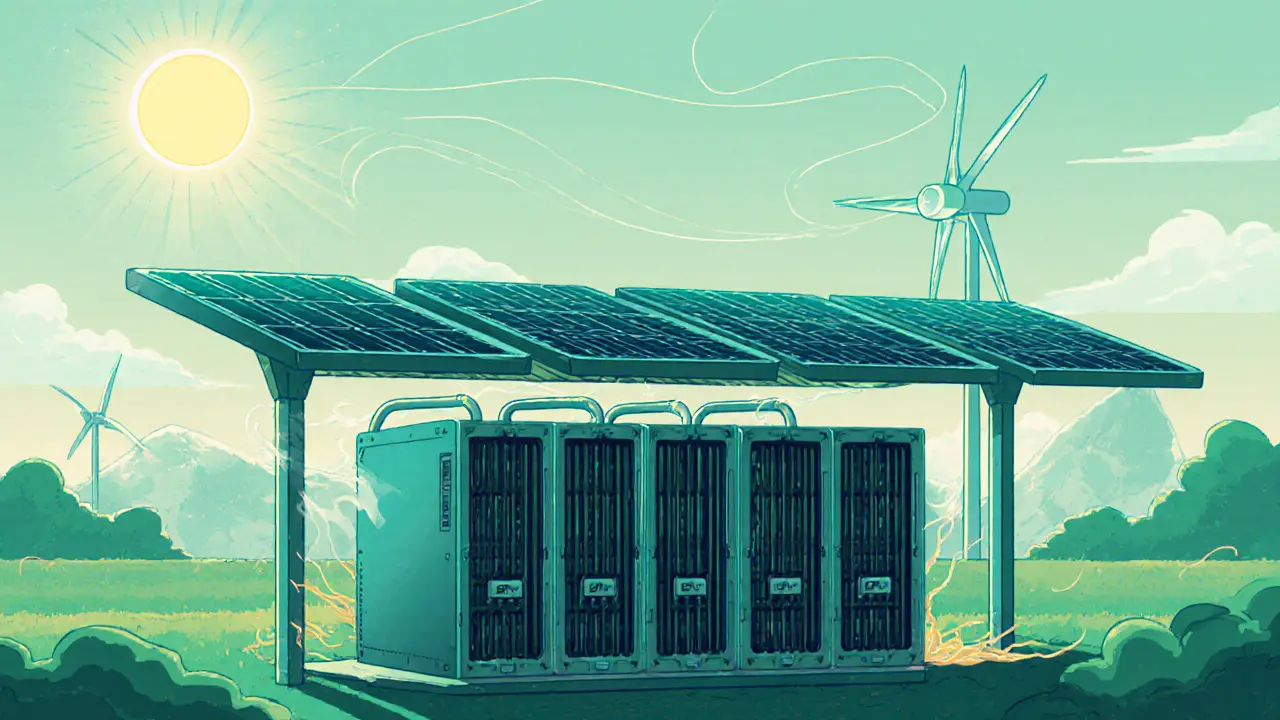- Home
- ::
- ASIC Miners Explained: How They Power Cryptocurrency Mining

ASIC Miners Explained: How They Power Cryptocurrency Mining
ASIC Miner Performance Calculator
Mining Performance Summary
Efficiency:
Daily Earnings:
Monthly Earnings:
Annual Earnings:
Net Annual Profit:
ROI Period:
| Metric | ASIC (Antminer S19 Pro) | GPU (RTX 3080) | CPU (Intel i9-13900K) |
|---|---|---|---|
| Hash Rate | 110 TH/s | 0.5 TH/s | 0.02 TH/s |
| Power Consumption | 3,250 W | 320 W | 125 W |
| Joules per Terahash | 29 J/TH | 640 J/TH | 6,250 J/TH |
| Initial Cost (USD) | $5,200 | $1,200 | $500 |
When you hear the term ASIC miner is a specialized hardware device built solely to solve a particular cryptographic algorithm for a blockchain network, you might picture a humming box in a garage or a massive rack in a data centre. In reality, an ASIC miner is the workhorse that keeps Bitcoin and many other Proof‑of‑Work coins moving, delivering hash power that ordinary computers simply can’t match. If you’re curious about why these machines matter, how they differ from GPUs or CPUs, and what you need to consider before buying one, you’ve landed in the right spot.
Quick Take
- ASIC miners are purpose‑built chips that hash a single algorithm (e.g., SHA‑256 for Bitcoin) at extreme speed.
- They outperform GPUs and CPUs by 10‑100× in hash rate while using far less electricity per hash.
- Major manufacturers include Bitmain (Antminer series) and Canaan Creative (Avalon line).
- Upfront costs run from a few hundred dollars for entry‑level units to tens of thousands for industrial models.
- Profitability hinges on electricity rates, mining difficulty, and the price of the coin you mine.
What Exactly Is an ASIC Miner?
An ASIC (Application‑Specific Integrated Circuit) miner is a chip designed to execute ONE cryptographic function over and over. Unlike a CPU that can run a spreadsheet or a GPU that renders video games, an ASIC’s circuitry is hard‑wired for a single task-solving the hash puzzle for a specific blockchain.
Because the chip never has to switch contexts or run generic code, it can calculate hashes millions of times per second. For Bitcoin’s SHA‑256 algorithm, modern units like the Antminer S19 Pro push around 110TH/s (terahashes per second) while sipping roughly 3250W of power.
How ASIC Miners Work
Mining is the process of confirming transactions and adding new blocks to a blockchain. Here’s the simplified flow:
- The network broadcasts a block header that includes a list of pending transactions.
- Miners repeatedly hash the header plus a changing "nonce" value.
- When a hash output falls below the network’s target difficulty, the block is considered solved.
- The winning miner broadcasts the solution, earns the block reward (new coins + fees), and the block is appended.
ASIC miners excel at step 2 because they can churn through billions of hash attempts per second, giving them a much higher chance of being the first to hit the target.
Why ASICs Beat GPUs and CPUs
| Metric | ASIC (Antminer S19 Pro) | GPU (RTX 3080) | CPU (Intel i9‑13900K) |
|---|---|---|---|
| Hash Rate | 110TH/s | 0.5TH/s (approx.) | 0.02TH/s (approx.) |
| Power Consumption | 3250W | 320W | 125W |
| Joules per Terahash | 29J/TH | 640J/TH | 6250J/TH |
| Initial Cost (USD) | $5200 | $1200 | $500 |
The table makes it crystal clear: ASICs deliver the most hashes for the least electricity, which is why they dominate Bitcoin mining. GPUs still have a role in mining coins that use different algorithms, such as Ethereum’s former Ethash (now PoS) or Ravencoin’s KawPoW, but they’re a poor fit for SHA‑256.

Major Players and Popular Models
Two companies dominate the market:
- Bitmain - Best known for the Antminer series. The current flagship, Antminer S19 Pro, blends raw power with a relatively efficient 29J/TH.
- Canaan Creative - Introduced the Avalon line. The Avalon110 offers a slightly lower hash rate (73TH/s) but a comparable efficiency.
Other noteworthy manufacturers include MicroBT (M30S++) and Bitfury (B8). All these devices share three core components: a set of ASIC chips, an integrated power supply, and a cooling system (typically multiple high‑speed fans).
Getting Started: What You Need to Run an ASIC Miner
Before you rush out to buy hardware, make sure you’ve covered these basics:
- Electricity cost analysis - Calculate watts per terahash and multiply by your local kWh rate. In the UK, average residential rates hover around £0.34/kWh, which can erode profits quickly.
- Stable power outlet - Most units require a dedicated 220‑240V circuit with a minimum amperage rating (often 10‑15A per miner).
- Cooling space - ASICs generate 2‑4kW of heat. A well‑ventilated room or industrial‑grade HVAC is essential.
- Internet connection - A wired Ethernet link with low latency ensures your miner stays in sync with the network.
- Mining pool membership - Solo mining a major coin like Bitcoin is practically impossible for a single device. Join a pool such as slushpool or F2Pool to receive steady payouts.
Setup steps are fairly straightforward: unpack, connect power and Ethernet, flash the firmware (most manufacturers provide a web‑based UI), input your pool credentials, and start the hash.
Cost, Profitability, and Risks
Profit calculators take three inputs - hash rate, power consumption, and electricity cost - then factor in the current coin price and network difficulty. As of October2025, a single Antminer S19 Pro at a UK electricity rate of £0.34/kWh yields roughly £1.8 per day in Bitcoin earnings, translating to about £650 annually after electricity expenses. That’s a modest return on a £5200 investment, highlighting two key risks:
- Difficulty spikes - Every two weeks the Bitcoin network adjusts difficulty. A sudden jump can make your miner temporarily unprofitable.
- Hardware obsolescence - Newer ASICs improve efficiency by 10‑15% each year. An older unit may become non‑competitive within 18‑24 months.
Some miners mitigate risk by diversifying into coins that use other algorithms (e.g., Litecoin’s Scrypt) or by securing low‑cost renewable energy contracts.
Future Trends: Efficiency, Sustainability, and the PoW Landscape
Environmental pressure is nudging manufacturers toward greener designs. The latest 2025 releases from Bitmain and MicroBT claim sub‑29J/TH efficiencies, achieved through smaller nanometer processes and advanced heat‑pipe cooling.
At the same time, the broader crypto ecosystem is seeing a shift: major coins like Ethereum have already moved to Proof‑of‑Stake, reducing the overall demand for mining hardware. Nonetheless, Bitcoin and a handful of other PoW chains (e.g., Litecoin, Dogecoin) remain dominant, meaning ASIC miners will stay relevant for the foreseeable future.
If you’re considering a new purchase, ask yourself whether you can lock in cheap electricity - perhaps via a partnership with a renewable‑energy farm - and whether you’re comfortable with the rapid hardware turnover that characterises this market.
Key Takeaways
- ASIC miners are ultra‑efficient, single‑algorithm devices that dominate SHA‑256 mining.
- They provide massive hash rates while consuming markedly less power than GPUs or CPUs.
- High upfront cost and electricity usage are the biggest barriers for hobbyists.
- Profitability hinges on electricity price, coin value, and network difficulty.
- The next wave focuses on even lower energy per hash and integration with renewable power sources.

Frequently Asked Questions
What does ASIC stand for?
ASIC means Application‑Specific Integrated Circuit - a chip built for one particular purpose, in this case solving a specific cryptographic hash.
Can I use an ASIC miner for any cryptocurrency?
No. ASICs are locked to a single algorithm. A SHA‑256 ASIC works for Bitcoin and Bitcoin‑derived coins, while a Scrypt ASIC (e.g., for Litecoin) won’t mine Bitcoin.
Do I need a mining pool?
For most miners, yes. Pooling your hash power with dozens or thousands of others gives you regular, predictable payouts rather than waiting years for a solo block.
How loud are ASIC miners?
Typical units run 60‑80dB - comparable to a busy office or a vacuum cleaner. Proper placement or sound‑absorbing enclosures are essential for home setups.
Is ASIC mining still profitable in 2025?
Profitability depends on electricity cost, coin price, and the specific model’s efficiency. With cheap renewable energy and a modern 2025‑era ASIC, you can break even or earn modest profit; otherwise, margins shrink quickly.


 Finance
Finance





Write a comment